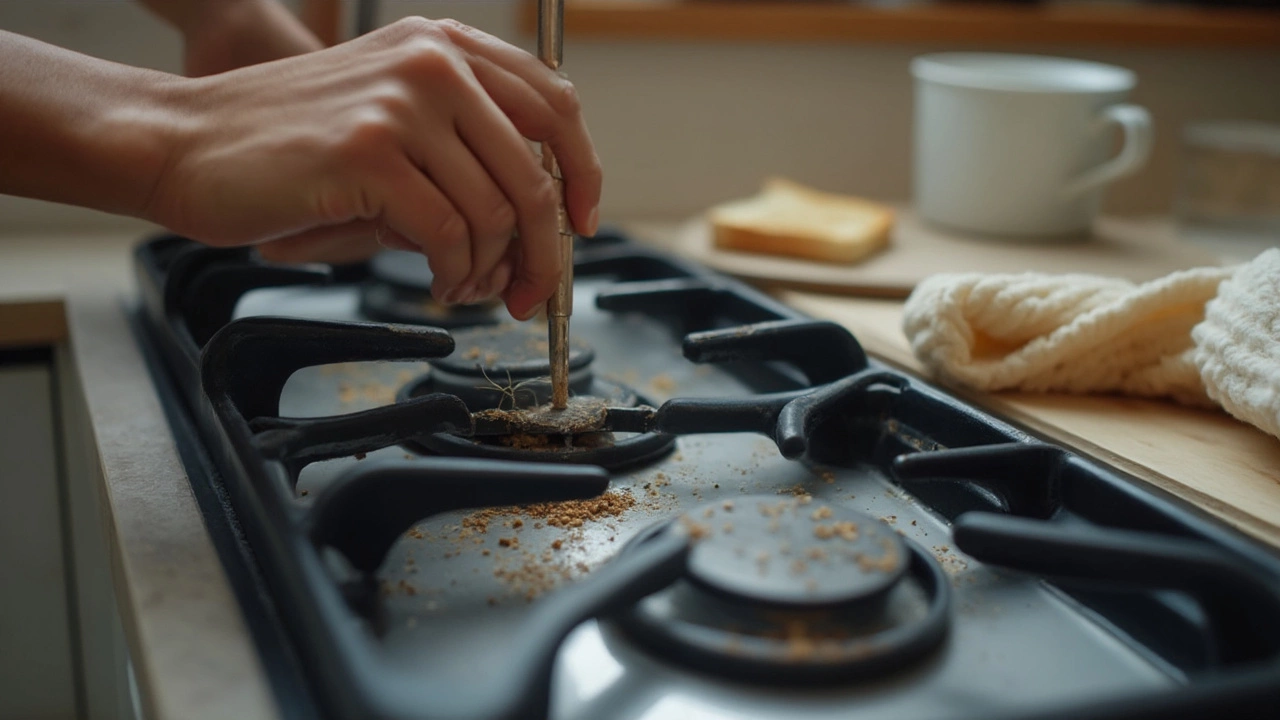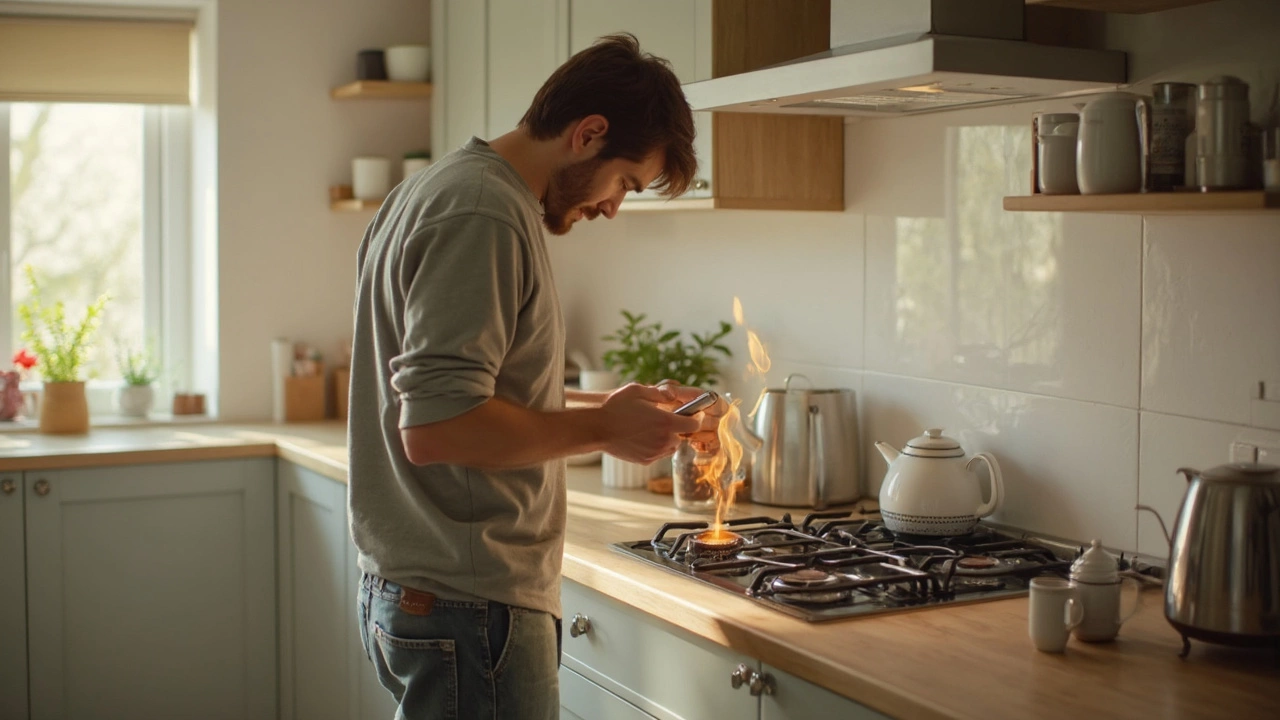You twist the knob, hear the clicks, but there’s no flame. Sound familiar? A gas hob that won’t light up is a kitchen letdown, but figuring out what’s wrong doesn’t need a degree in engineering.
The usual suspects are simpler than you might think—blocked burner holes, food spills clogging things up, or a spark that just won’t spark. Sometimes, it’s just a loose connection underneath or even a dead battery if your hob uses one for ignition.
Before you panic or start searching for a replacement, know this: lots of issues are things you can spot and sometimes fix yourself. Just understanding what causes these breakdowns can save you time, money, and a cold dinner.
- Why Gas Hobs Fail: The Real Culprits
- Easy Checks and DIY Solutions
- When to Call a Professional
- How to Keep Your Gas Hob Running Smoothly
Why Gas Hobs Fail: The Real Culprits
Nothing ruins dinner vibes faster than a gas hob that won’t fire up. The good news? Most failures come down to a few repeat offenders. Here’s what’s really going on when your hob is not working.
1. Blocked Burners
If your gas stove clicks but doesn’t light, food bits or grease could be clogging the tiny holes in the burner. These clogs stop the gas from coming out evenly or at all. Even a small amount of gunk can mess up the flame.
2. Ignition Problems
Ever hear clicking but see no spark? Ignition switches or the tiny electrode that creates the spark can fail after years of use or if they get wet. On some models, a dead battery under the hob panel is the culprit.
3. Gas Flow Issues
No gas, no flame. This can happen if the gas supply valve is accidentally switched off or if there’s a kink in a flexible hose. Sometimes, regulators get stuck or wear out, cutting off your gas supply.
4. Faulty Knobs and Connections
It sounds simple, but knobs can crack or their internal parts break, making them turn without controlling the actual gas flow. Loose wires underneath mean bad connections for ignition or gas control.
- If your hob only fails on one burner, it’s likely a blocked jet or dirty ignitor.
- If none of the burners work, always check if the main gas supply is on and working elsewhere in the house.
- Odd smells (like rotten eggs) are a sign of a gas leak, not just a faulty hob. Stop and call a pro.
Want some numbers? Around 70% of hob repair callouts are just a matter of cleaning out the burner or fixing a minor ignition issue. It’s way more common than full-on part replacements.
Knowing these usual suspects helps you zero in on what’s wrong—and sometimes fix it on the spot, without waiting for a technician.
Easy Checks and DIY Solutions
Don’t grab the phone for a repair tech just yet. Lots of gas hob problems have simple causes you can handle yourself. Grab a flashlight and follow these steps before you shell out any cash.
- Check for Blocked Burners: Food spills, especially sauces and liquids, quickly clog the tiny burner holes. If you see gunk or residue, let the burner cool, then clean it with a toothbrush or a pin. Make it a habit to wipe burners after heavy use. Fun fact: clogged burners are the #1 reason gas hobs won’t ignite in home kitchens.
- Inspect the Ignition System: When you push and turn the knob, you should hear a ticking sound—the ignitor sparking. If you don’t, double-check if your gas hob uses a battery for ignition (many do; it’s usually tucked underneath or behind a side panel). Pop in a fresh battery if in doubt.
- Look for Loose or Wet Connections: Sometimes burners don’t fire because the electrical contacts are damp (think: after cleaning with too much water) or have become loose. Carefully dry all controls and burner areas with a paper towel and try again.
- Test for Gas Supply: Smell gas but see no flame? Make sure the main gas valve is open, and the supply line to your hob is kink-free. If everything’s open and safe but nothing lights, it could be a gas supply problem—worth checking if the other gas appliances work.
Here’s a quick chart showing the most common quick fixes and how much time they usually take:
| Problem | Typical Fix | Time Needed |
|---|---|---|
| Blocked burner | Clean with pin/brush | 5-10 min |
| Battery flat | Replace battery | 2 min |
| Wet ignition | Dry out area | 10-15 min |
| Gas off | Turn on gas valve | 1 min |
One tip: never use sharp metal objects that could damage the burner holes permanently. Stick to wooden toothpicks or old toothbrushes for cleaning if you want your hob to last.

When to Call a Professional
There are times when rolling up your sleeves just isn’t enough, and that’s when calling a pro for your gas hob makes sense. Messing with gas lines or complex parts can get risky fast—not just for the appliance but for your safety.
If you smell gas, shut everything off and get out. Don’t try to fix leaks yourself, ever. In the UK, for example, only a Gas Safe registered engineer can even touch gas appliances by law, and that rule is there for good reason. According to a 2023 survey, faulty gas appliances caused over 2,000 house incidents in just one year. Not worth chancing it!
Other signs you need professional help for your hob not working or repair issues:
- You’ve cleaned the burners and checked the connections but there’s still no flame.
- The ignition keeps sparking nonstop or won’t spark at all, even after replacing the battery.
- Something smells burnt underneath or you spot scorch marks around controls—wiring could be damaged.
- The gas flow seems weak or uneven, even with a full cylinder or working mains line.
- There’s visible physical damage, like cracked hob glass or bent burner rings.
If your gas stove is still under warranty, don’t do anything that could void the guarantee. Most manufacturers actually require certified repairs to keep warranties valid, so always check your paperwork before letting anyone (even yourself) take things apart.
Safe bets? Always hire a trained gas engineer when in doubt. The callout might cost a little extra, but it’s a small price compared to the risks or the cost of a whole new appliance.
How to Keep Your Gas Hob Running Smoothly
If you want your gas hob making dinners for years, it pays to show it a little regular love. Most problems pop up because people forget about the basic stuff. Here’s what actually helps:
- Wipe down burners regularly. Food spills glue themselves into the tiny holes where the flames come out. All it takes is a soft brush or a toothpick—don’t use anything metal that could make the holes even bigger.
- Keep the ignition clean and dry. The electric spark won’t work if grease or water gets in there. Gently clean the area with a dry cloth and skip any harsh cleaners that leave residue.
- Check for loose parts. Every few weeks, see if the burner caps, pan stands, or control knobs are still snug. Even small wobbles can mess with the flame.
- Leave enough space around your hob. Good airflow stops overheating and keeps the ignition parts happy. Don’t crowd your hob with kitchen gear.
- Test the flame color. You want clean blue flames, not yellow or orange. A yellow flame means there’s junk in the burner or the gas-to-air mix is off. That’s a sign you should give things a deeper clean or call in a pro.
People who stay on top of these checks and clean-ups report fewer breakdowns and lower repair costs. In fact, a recent home appliance survey showed that households who clean their gas hob burners monthly have 40% fewer repair visits than those who wait until things go wrong.
| Maintenance Habit | Frequency | Expected Outcome |
|---|---|---|
| Wipe Burners/Caps | Weekly | Stops blockages & ignition failures |
| Inspect Ignition | Monthly | Prevents spark issues |
| Check Connections | Monthly | Catches loose/broken parts early |
One last tip: always use the right-sized pots and pans. When you use giant cookware on a tiny burner, the heat can build up where it shouldn’t and wear things out faster than you’d expect. Small habits like these keep your gas hob hassle-free and ready to go.
